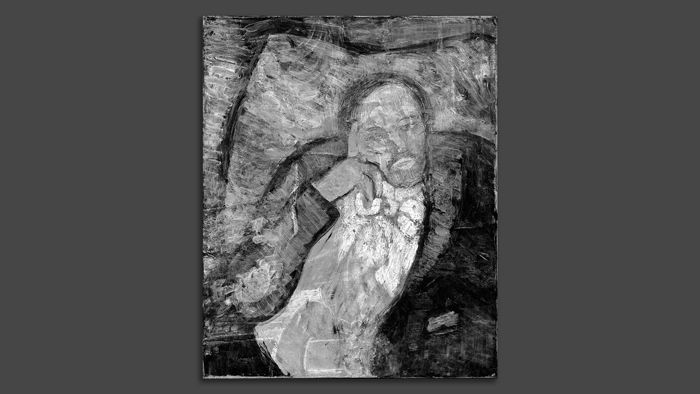Beneath some of Picasso's iconic paintings, researchers are finding new details about hidden portraits and compositions.
Why it matters: The discoveries, being presented in a new exhibition, offer clues about the artist's materials and process early in his career — and how to better conserve his work.
"The technical studies were able to inform art historical research at a new level," says Patricia Favero, an associate conservator at the Phillips Collection in Washington, D.C.
- Favero is part of a team of conservators and scientists that studied three Picassos that are now in an exhibition about the artist's Blue Period.
- Earlier studies have used imaging techniques to study aspects of these and other paintings on recycled canvases, which Picasso was known to use.
- The first clue that there was a painting beneath "The Blue Room" (1901) was spotted more than 60 years ago. Some of the paint texture reflects brush strokes in different directions than the composition that is seen.
What's new: Combining data from X-radiography, infrared (IR) reflectance imaging spectroscopy, and X-ray fluorescence mapping, a team of researchers from the Phillips, the National Gallery of Art and other institutions were able to see a portrait of a man, indicators of the brush and strokes, and the pigments the artist used. For example, the presence of mercury suggests he was painting with vermilion.
- Microanalysis of tiny samples of the painting indicate most of "The Blue Room" is painted directly on top of the portrait, without priming, and that Picasso's palette was becoming more subdued.

With IR reflectance spectroscopy, the researchers could see forms beneath the right shoulder and forearm of the woman in "Crouching Beggarwoman" (1902).
- Using X-ray fluorescence scanning, the chemical elements in the paint were mapped, revealing information about the stages in which the painting was developed — an arm exposed, then later covered.
- Conservators already knew a landscape painting — its creator unknown but its range of colors is similar to Picasso's — was under the portrait, but the analyses provided new details about how the hills in the painting later became the back of the crouched woman.
A map of the elements in the paint of "The Soup" (1903) suggests Picasso changed the shape of the bowl being offered to a child by a woman and that he altered the woman's gesture and how her hair fell from her forehead.
- Other imaging tools suggest the painting was first a still life, parts of it scraped off rather than painted over.
The bottom line: "There is still more to learn from some of the world's most studied paintings," Favero says.







